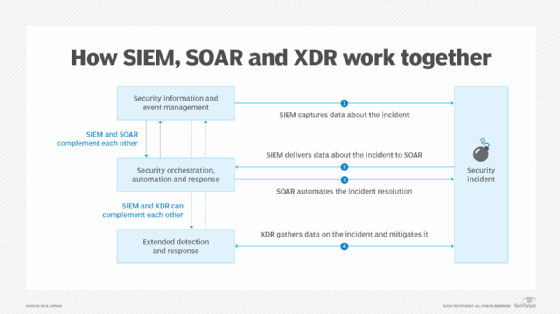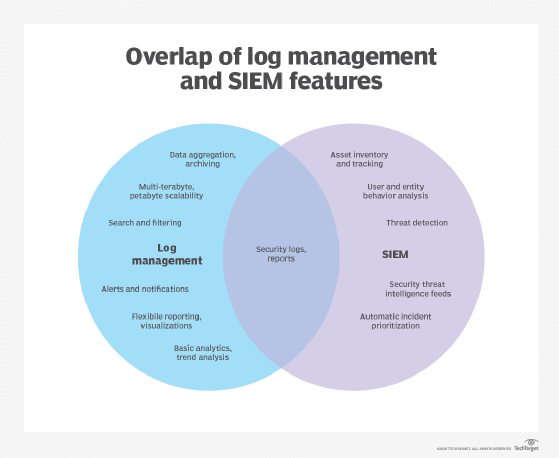What is SIEM (security information and event management)?
SIEM (security information and event management) is software that helps organizations detect, analyze, and respond to security threats by collecting and correlating security event data from across the IT environment in real time.
The underlying principles of every SIEM system are to aggregate relevant data from multiple sources, identify deviations from the norm and take appropriate action. For example, when a potential issue is detected, a SIEM system might log additional information, generate an alert and instruct other security controls to stop an activity's progress. SIEM systems can gather data from user devices, servers, network equipment, firewalls, antivirus programs and other security-related software.
Payment Card Industry Data Security Standard compliance originally drove SIEM adoption in large enterprises, but concerns over advanced persistent threats have led smaller organizations to consider the benefits SIEM tools can offer. Being able to view all security-related data from a single point of view makes it easier for organizations of all sizes to spot unusual patterns.
How SIEM works
At the most basic level, a SIEM system can be rules-based or employ a statistical correlation engine to connect event log entries. Its operation can be divided into three main steps: log management, event correlation and analytics, and incident monitoring and security alerts.
This article is part of
What is threat detection and response (TDR)? Complete guide
1. Log management
SIEM tools gather event and log data created throughout a company's infrastructure. They work by deploying multiple collection agents in a hierarchical manner, gathering security-related events from host systems, including end-user devices, servers, network equipment, cloud services and specialized security equipment such as firewalls, antivirus programs or intrusion prevention systems. The goal of these collectors is to bring all this data together on a centralized platform.
2. Event correlation and analytics
The collectors then forward events to a centralized management console, normalizing different data types. A collection of algorithms, predefined rules and machine learning (ML) processes sifts through the data to identify patterns and activities that could be security incidents.
In some systems, preprocessing can happen at edge collectors, with only certain events being passed through to a centralized management node. In this way, the volume of information being communicated and stored can be reduced. Although ML advancements are helping systems flag anomalies more accurately, analysts must still provide feedback, continuously educating the system about the environment.
Advanced SIEM systems have evolved to include user and entity behavior analytics, and security orchestration, automation and response (SOAR) capabilities. They all work together to respond effectively to security incidents.

3. Incident monitoring and security alerts
SIEM tools identify and sort the collected data into categories such as successful and failed logins, malware activity and other likely malicious activity.
The SIEM software generates security alerts when it identifies potential security issues. Using a set of predefined rules, organizations can set these alerts as low or high priority.
For instance, a user account that generates 25 failed login attempts in 25 minutes could be flagged as suspicious but still be set at a lower priority because the login attempts were probably made by a user who forgot their login information. However, a user account that generates 130 failed login attempts in five minutes would be flagged as a high-priority event because it is most likely a brute-force attack in progress.
Why is SIEM important?
SIEM helps organizations improve their security posture, as it aids in detecting and responding to security threats in real time. It also assists in the following activities:
- Security management. SIEM makes it easier for enterprises to manage security by filtering massive amounts of security data and prioritizing the security alerts the software generates.
- Threat detection. SIEM software enables organizations to detect incidents that might otherwise go undetected. It analyzes the log entries to identify signs of malicious activity.
- Attack timelines. Since the system gathers events from different sources across the network, it can recreate an attack's timeline, enabling an organization to determine its nature and effect on the business.
- Regulatory compliance and reporting. A SIEM system can also help an organization meet compliance requirements and regulatory standards by detecting security compliance failures across the organization's infrastructure and by automatically generating reports that include all the logged security events from these sources. Without SIEM software, the company would have to gather log data and compile the reports manually.
- Incident management. A SIEM system also enhances incident management by helping the company's security team uncover the route an attack takes across the network, identify the compromised sources, and provide automated tools to prevent attacks in progress.
Benefits of using SIEM
SIEM offers the following benefits:
- Minimizes threat damage. SIEM significantly shortens the time it takes to identify threats, minimizing the damage from those threats.
- Increases security visibility. SIEM offers a holistic view of an organization's information security environment, making it easier to gather and analyze security information to keep systems safe. All an organization's data goes into a centralized repository where it's stored and easily accessible.
- Offers flexible use cases. Companies can use SIEM for various use cases involving data or logs, including security programs, audit and compliance reporting, help desk and network troubleshooting.
- Enhances scalability. SIEM supports large amounts of data, enabling organizations to continue to scale out and add more data.
- Generates alerts. SIEM provides threat detection and security alerts.
- Performs in-depth analysis. It can perform detailed forensic analysis in the event of major security breaches.
- Offers AI and ML features. AI and ML features enable SIEM systems to automatically analyze data and learn from network behavior.
Challenges and limitations of SIEM
Despite its benefits, SIEM also has the following limitations:
- Long deployment time. Implementing SIEM can take a long time because it requires support to ensure successful integration with an organization's security controls and the many hosts in its infrastructure. It typically takes 90 days or more to install SIEM before it starts to work.
- It's expensive. The initial investment in SIEM can be in the hundreds of thousands of dollars. And the associated costs can add up, including the costs of personnel to manage and monitor a SIEM implementation, annual support and software or agents to collect data.
- Requires expertise. Analyzing, configuring and integrating reports requires the talent of experts. That's why some SIEM systems are managed directly within a security operations center, a centralized unit staffed by an information security team that deals with an organization's security issues.
- Generates numerous alerts. SIEM tools usually depend on rules to analyze all the recorded data. The problem is that a company's network could generate thousands of alerts per day. It's difficult to identify potential attacks because of the number of irrelevant logs.
- Misconfigurations. A misconfigured SIEM tool might miss important security events, making information risk management less effective.
Best practices for implementing SIEM
Organizations should follow these best practices while implementing SIEM:
1. Set understandable goals
The SIEM tool should be selected and implemented based on security goals, compliance requirements and the potential threat landscape of the organization.
2. Identify compliance requirements
Determine what regulatory standards must be met. This helps ensure the chosen SIEM software is configured to audit and report on the correct compliance standards.
3. List digital assets
Listing all digitally stored data across an IT infrastructure helps manage log data and monitor network activity.
4. Apply data correlation rules
Data correlation rules should be implemented across all systems, networks and cloud deployments. This should reduce noise and make finding data with errors easier.
5. Record incident response plans and workflows
Document how teams will respond to specific issues. This helps ensure teams can rapidly respond to security incidents.
6. Assign a SIEM administrator
A SIEM administrator ensures the proper maintenance of a SIEM implementation. They should oversee areas such as general operations, maintenance, optimization and alert management.
7. Automate
Use AI and ML features to improve and automate data analysis, threat detection and response actions.
How to choose a SIEM tool
The key to selecting the right SIEM tool varies depending on several factors, including an organization's budget and security posture. To pick the right tool, companies should evaluate each option based on the following factors:
- Integration with existing architecture. Verify that the SIEM tool integrates properly with the organization's existing systems.
- Cost. The cost of a SIEM tool and the cost of implementing one can vary significantly. Cloud-based tools might be less expensive, whereas more enterprise-oriented software will be pricier to license and integrate.
- On-premises, hybrid or cloud-based. Determine if the tool supports deployment models that align with the organization's needs.
- Vendor support. Organizations should also consider the level of support the SIEM vendor can provide, including technical support, training and community resources.
Users should also ask the following questions about SIEM product capabilities:
- Integration with other controls. Can the system give commands to other enterprise security controls to prevent or stop attacks in progress?
- AI. Can the system improve its own accuracy through ML and deep learning?
- Threat intelligence feeds. Can the system support threat intelligence feeds of the organization's choosing, or is it mandated to use a particular feed?
- Extensive compliance reporting. Does the system include built-in reports for common compliance needs and enable the organization to customize or create new compliance reports?
- Forensic capabilities. Can the system capture additional information about security events by recording the headers and contents of packets of interest?
SIEM features and capabilities
Important features to consider when evaluating SIEM products include the following:
- Data aggregation. Data is collected and monitored from applications, networks, servers and databases.
- Correlation. Typically, a part of security event management (SEM) in a SIEM tool, correlation refers to the tool finding similar attributes between different events.
- Dashboards. Data is collected and aggregated from applications, databases, networks and servers and is displayed in charts to help find patterns and to avoid missing critical events.
- Alerting. If a security incident is detected, SIEM tools can notify users.
- Automation. Some SIEM software might include automated security incident analysis and automated incident responses.
- Compliance reporting. SIEM tools can generate reports that help organizations ensure they are adhering to regulatory frameworks.
- Incident response and forensics. SIEM tools can capture incident timelines, which can aid in tracking and responding to security incidents.
- Database and server access monitoring. SIEM tools can identify unauthorized access or other anomalies to databases and servers.
- Internal and external threat detection. SIEM tools can detect internal and external threats.
- Real-time monitoring. SIEM software can offer real-time threat monitoring, correlation and analysis across various applications and systems.
- User activity monitoring. SIEM software can monitor user behavior to detect abnormal actions or compliance failures.
SIEM tools and software
There are a wide variety of SIEM tools on the market, including the following:
- Datadog Cloud SIEM. Datadog Cloud SIEM from Datadog Security is a cloud-native network and management system. The tool features both real-time security monitoring and log management.
- Exabeam. Exabeam Inc.'s SIEM portfolio offers a data lake, advanced analytics and a threat hunter.
- IBM QRadar. The IBM QRadar SIEM platform provides security monitoring for IT infrastructures. It features log data collection, threat detection and event correlation.
- LogRhythm. LogRhythm is a SIEM system for smaller organizations. It unifies log management, network monitoring and endpoint monitoring, as well as forensics and security analytics.
- ManageEngine Log360. The Log360 SIEM tool offers threat intelligence, incident management and SOAR features. Log collection, analysis, correlation, alerting and archiving features are available in real time.
- NetWitness. The NetWitness platform from PartnerOne is a threat detection and response tool that includes data acquisition, forwarding, storage and analysis.
- SolarWinds Security Event Manager. The SolarWinds SIEM tool automatically detects threats, monitors security policies and protects networks. It offers features such as integrity monitoring, compliance reporting and centralized log collection.
- Splunk. The Splunk on-premises SIEM system offers continuous security monitoring, advanced threat detection, incident investigation and incident response.
History of SIEM
SIEM technology, which has existed since the mid-2000s, initially evolved from log management, which is the collective processes and policies used to administer the generation, transmission, analysis, storage, archiving and disposal of large volumes of log data created within an information system.

Gartner analysts coined the term SIEM in the 2005 Gartner report, "Improve IT Security with Vulnerability Management." In the report, the analysts proposed a new security information system based on security information management (SIM) and SEM.
Built on legacy log collection management systems, SIM introduced long-term storage analysis and reporting on log data. It also integrated logs with threat intelligence. SEM addressed identifying, collecting, monitoring and reporting security-related events in software, systems or IT infrastructure.
Vendors created SIEM by combining SEM -- which analyzes log and event data in real time and provides threat monitoring, event correlation and incident response -- with SIM, which collects, analyzes and reports on log data.
SIEM is now a more comprehensive and advanced tool. New features were introduced for reducing risk in an organization, such as SOAR and the use of ML and AI to help systems flag anomalies accurately.
The future of SIEM
Future SIEM trends might include the following:
- Improved orchestration. Currently, SIEM only provides companies with basic workflow automation. However, as these organizations continue to grow, SIEM must offer additional capabilities. For example, with AI and machine learning, SIEM tools must offer faster orchestration to provide the different departments within a company the same level of protection. Additionally, the security protocols and the execution of those protocols will be faster, more effective and more efficient.
- Better collaboration with managed detection and response (MDR) tools. As threats of hacking and unauthorized access continue to increase, it's important that organizations implement a two-tier approach to detect and analyze security threats. A company's IT team can implement SIEM in-house, while a managed service provider can implement the MDR tool.
- Enhanced cloud management and monitoring. SIEM vendors will improve the cloud management and monitoring capabilities of their tools to better meet the security needs of organizations that use the cloud.
- SIEM and SOAR will evolve into one tool. Look for traditional SIEM products to take on the benefits of SOAR; however, SOAR vendors will likely respond by expanding the capabilities of their products.
According to predictions from Forbes, the future of SIEM might involve the following five possible outcomes:
- Usage-based pricing models for SIEM will become common.
- Analysis tools will be built on universal SIEM data platforms.
- Organizations will partner to provide more integrations.
- The cost of SIEM will drop, making it more affordable for smaller security teams.
- Startups will address more of the multifaceted challenges of managing security.
Learn how AI-powered threat detection uses machine learning to manage cybersecurity.





